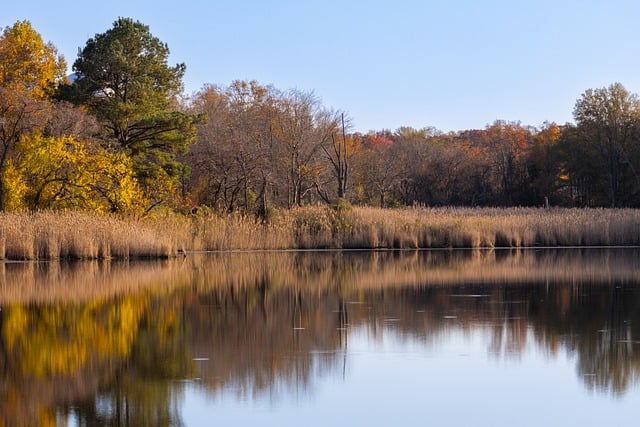Embarking on an outdoor pond project can transform your backyard into a serene sanctuary. This article serves as a comprehensive guide for enthusiasts looking to master the art of pond design and maintenance. We’ll explore key considerations for installation, the biodiversity benefits these ecosystems offer, and the enchanting addition of an outdoor waterfall. With professional insights on balancing your pond’s ecosystem year-round, you’re set to create a thriving habitat right in your own outdoor space.
- Mastering the Art of Design: Key Considerations for Outdoor Pond Installation
- The Blueprint of Biodiversity: How an Outdoor Pond Supports Wildlife
- Waterfall Wonders: Enhancing Your Outdoor Pond with a Natural Cascade
- Maintenance Matters: Keeping Your Outdoor Pond Ecosystem Balanced and Healthy Year-Round
Mastering the Art of Design: Key Considerations for Outdoor Pond Installation

The Blueprint of Biodiversity: How an Outdoor Pond Supports Wildlife

An outdoor pond serves as a vital habitat, fostering biodiversity by supporting a myriad of wildlife species. The interplay of water and vegetation creates a microecosystem rich in oxygen and nutrients, essential for aquatic life such as fish, amphibians, and invertebrates. These ponds provide breeding grounds for various species of dragonflies and damselflies, contributing to the ecological balance. Moreover, the presence of outdoor waterfalls within the pond enhances this ecosystem by offering a continuous flow of water that aerates the environment, maintains water quality, and supports the movement of aquatic organisms. The cascading water of an outdoor waterfall also serves as a natural filtration system, aiding in the removal of waste products and keeping the pond’s biodiversity thriving.
Incorporating native plants around the pond not only adds aesthetic value but also supports local wildlife by offering nectar and pollen sources for bees and butterflies, as well as cover and food for birds and small mammals. The diverse vegetation surrounding an outdoor pond can act as a buffer against environmental stressors such as pollution and extreme weather, ensuring the stability of the pond’s ecosystem. Additionally, the strategic placement of these water features within a landscape design can create a harmonious blend with the natural environment, enhancing the outdoor living space while providing critical habitats for various species. By adhering to ecological principles in pond construction and maintenance, landowners can significantly contribute to preserving biodiversity and promoting healthy ecosystems.
Waterfall Wonders: Enhancing Your Outdoor Pond with a Natural Cascade

Maintenance Matters: Keeping Your Outdoor Pond Ecosystem Balanced and Healthy Year-Round

Maintaining a balanced and healthy ecosystem in your outdoor pond is an ongoing process that requires diligence and attention throughout the year. The health of your pond, which includes features like outdoor waterfalls, is deeply intertwined with its biological balance, plant life, and water quality. Regular maintenance activities, such as monitoring and adjusting water levels, skimming out debris, and cleaning filters, are crucial to prevent stagnation and ensure the circulation of fresh, oxygen-rich water. Additionally, testing the pH and ammonia levels will help you maintain the ideal conditions for aquatic life to thrive. During colder months, care must be taken to protect your pond from freezing over completely, as ice can suffocate fish and disrupt the ecosystem. Investing in deicers or carefully managing water temperatures ensures that your outdoor pond remains a vibrant, self-sustaining habitat year-round.
Seasonal changes bring unique maintenance challenges to your outdoor pond. In summer, algae blooms can become problematic, leading to poor water quality and affecting the overall health of the ecosystem. Implementing strategies like appropriate shading, using beneficial bacteria supplements, and possibly introducing natural predators for algae can help manage these issues. As autumn approaches, preparing your pond for colder temperatures involves removing and storing any electronic equipment to prevent damage from freezing. It’s also a good time to ensure that your pond’s depth allows for the thermal layering of water, which can insulate the deeper areas where fish can survive. By proactively managing your outdoor pond with these considerations in mind, you can create and maintain a serene, balanced environment that offers a focal point of beauty and tranquility in your outdoor space, especially when enhanced by an outdoor waterfall.
Crafting an outdoor pond is more than a mere landscaping endeavor; it’s an ecosystem that can harmonize with nature while enhancing your outdoor space. The process demands careful design consideration, as outlined in “Mastering the Art of Design,” to ensure both aesthetic appeal and functionality. By supporting local wildlife, as detailed in “The Blueprint of Biodiversity,” your pond becomes a vital habitat, contributing to the larger environmental tapestry. The addition of an outdoor waterfall, as highlighted in “Waterfall Wonders,” not only adds a tranquil element to your garden but also plays a role in maintaining the pond’s balance and oxygen levels. Finally, consistent maintenance, discussed in “Maintenance Matters,” is key to keeping your pond ecosystem thriving throughout all seasons. Professional guidance at each stage is invaluable for creating and sustaining a healthy and beautiful outdoor pond that becomes a focal point of your outdoor living space.
